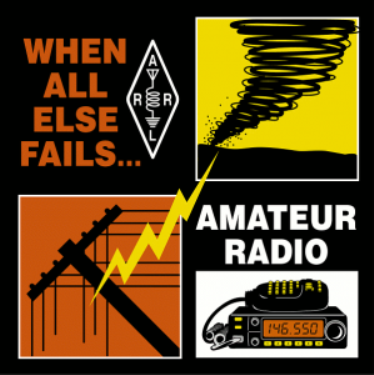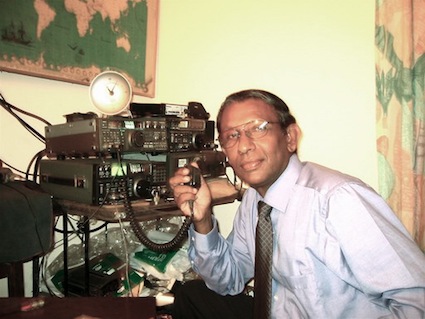Five years ago, in the immediate aftermath of the Indian Ocean Tsunami, amateur radio helped revive emergency communications with some of the worst affected locations.
The decades old practice was hailed as the ‘low tech’ miracle that literally helped save lives. Where electricity and telephone services — both fixed and mobile — had been knocked down, amateur radio enthusiasts (or ‘radio hams’) restored the first communication links.
They were at the forefront of relief efforts, for example, in the Andaman and Nicobar Islands in India, and in Hambantota in southern Sri Lanka.

Within hours of the tsunami, a short wave radio link was established between the disaster management operation at the Prime Minister’s office in the capital Colombo and government offices in the stricken south.
“We went in because the District Secretaries office only had a satellite phone and communications was difficult,” recalled Victor Goonetilleke, then President of the Radio Society of Sri Lanka (RSSL). The service was discontinued when other disrupted communications networks resumed.
As he later summed up: “When all else is dead, short wave is alive.”
Goonetilleke, one of the island’s best known radio hams (call sign: 4S7VK), reported at the time that “uncomplicated shortwave” radio saved the day. And it was accomplished by unpaid radio enthusiasts using nothing more than basic equipment and determination. The only cost to the state was providing food for volunteers operating round the clock.
Sir Arthur C Clarke, inventor of the communications satellite and long time resident of Sri Lanka, wrote in Wired magazine: “We might never know how many lives they saved and how many minds they put at ease, but we owe a debt to Marconi’s faithful followers.”
Sidelined and overlooked
Now, fast forward five years to the present. Notwithstanding their celebrated role after the tsunami, radio hams have been sidelined in Sri Lanka. Their very hobby is being frowned upon by the state on the grounds of…national security.
“As the applause died away, everything was forgotten,” Victor Goonetilleke recalled last week in an email interview. The only recognition in Sri Lanka was ‘a very appreciative letter’ from President Mahinda Rajapakse, who as Prime Minister at the time spearheaded the governmental response to the tsunami.

Encouragingly, however, the Radio Society received awards and accolades from Europe, Japan and India for their post-Tsunami work.
In the months following the mega-disaster, Sri Lanka passed a new disaster law and set up a new public institution mandated to coordinate disaster risk reduction and emergency responses.
“We have made presentations and participated in every disaster management seminar, but no follow up has taken place despite standing ovations at such seminars/meetings,” says a dejected Goonetilleke, who is currently secretary and disaster operations manager of the Radio Society.
The provisions for involving radio hams already exist. A disaster mitigation plan by the Telecom Regulatory Commission of Sri Lanka (TRCSL) some years ago listed the integration of amateurs in disaster recovery action.
Looking back, it seems like the public-spirited radio hams were given their 15 minutes of fame and then soundly ignored. Worse, the short-lived prominence may have attracted new bureaucratic hurdles.
For example, disaster communication equipment donated by foreign amateur radio groups was held up for two years pending clearance from the Customs and Ministry of Defence. These were released only after the ‘direct intervention’ of the Secretary to the President, says Goonetilleke.
The reason for such official hesitation was probably the long-drawn civil war in Sri Lanka, which intensified in 2006. Now, more than six months after the war ended in May 2009, the ‘temporary’ restrictions have not been lifted. Radio hams are both puzzled and frustrated by this.
“This is the irony,” says Goonetilleke. “Amateur Radio assisted and offered help — unasked — at tsunami time, and during the 30 year war, helped the security forces in many ways at a crucial time when our forces were caught unprepared and inadequately unequipped.”
He is emphatic that during the entire war, no amateur radio enthusiast was ever involved any violation. “Even their equipment, however meagre, (was) never robbed by terrorists.”
Poorly understood
One reason for this bureaucratic negativity may be simple ignorance of what amateur radio really is — reflecting the disturbingly low levels of media literacy in Sri Lanka.
In fact, ‘Marconi’s faithful followers’ have been indulging in their serious hobby for a full century. It relies on short waves, in the frequency range of 3,000 to 30,000Â kHz, or 3 to 30 MHz. These waves propagate by bouncing off the ionosphere and the Earth’s surface, thus travelling long distances.
Today, an estimated six million worldwide engage in this pursuit for recreation, self-training or public service. It requires considerable knowledge, skill and time — the term “amateur” merely implies they are not in it for making money. It’s used in the same sense as an amateur athlete.
Radio hams use various transmission modes, including the Morse code, radioteletype, data and voice. Around the world, radio hams are licensed to operate two-way communications equipment using radio frequencies set aside for this purpose. This allocation is done nationally by telecommunications regulators (TRCSL in Sri Lanka) and globally by the International Telecommunications Union (ITU).
Amateur radio is not to be confused with community radio, a localised method of broadcasting mostly using the FM band of the spectrum.
In this era of advanced communications systems, amateur radio remains an important part of emergency communications after disasters. Recent examples include terrorist attacks on the World Trade Centre twin towers in New York September 2001, Hurricane Katarina in New Orleans in August 2005, and China’s Sichuan earthquake in May 2008.
One main reason for this appeal is its amazing simplicity: radio hams can mobilise quickly, improvising on antennas and power sources. Most of their equipment can be powered by a car battery. Even when batteries drain too low for voice, the last bit of power can support exchanges in the Morse code.
Perhaps the low tech, low key nature of amateur radio contributes to its image problem. The proven technology has few champions among development donors or humanitarian relief agencies. Most radio hams are too busy with their hobby in their spare time to do much ‘marketing’ for their pursuit.
Goonetilleke feels amateur radio is ‘worse off than ever’ since the Radio Society was established in 1950. The non-profit-making group now has 210 members, of whom 120 are amateur radio license holders.
He laments: “Today…the service is treated as a threat or hindrance by the defence authorities, not granting clearance for equipment (or) new licences for those who have passed.”
Other constraints include the high cost of equipment compounded by high customs duties and other tariffs. But even if these can be overcome with the generous support of foreign amateur radio clubs, security clearance remains a big challenge.
The amateur radio community in Sri Lanka is also not attracting enough young blood to keep it going, partly because obtaining an amateur radio license is a tedious process. There is also the appeal of newer, flashier technologies such as Internet, mobile phones and video games.
Radio hams keep springing to action in times of distress. But who will respond when amateur radio itself sends out an SOS?
Science writer Nalaka Gunawardene studies how communications technologies impact society, and has been calling for enhanced media literacy in Sri Lanka. He blogs at http://movingimages.wordpress.com
